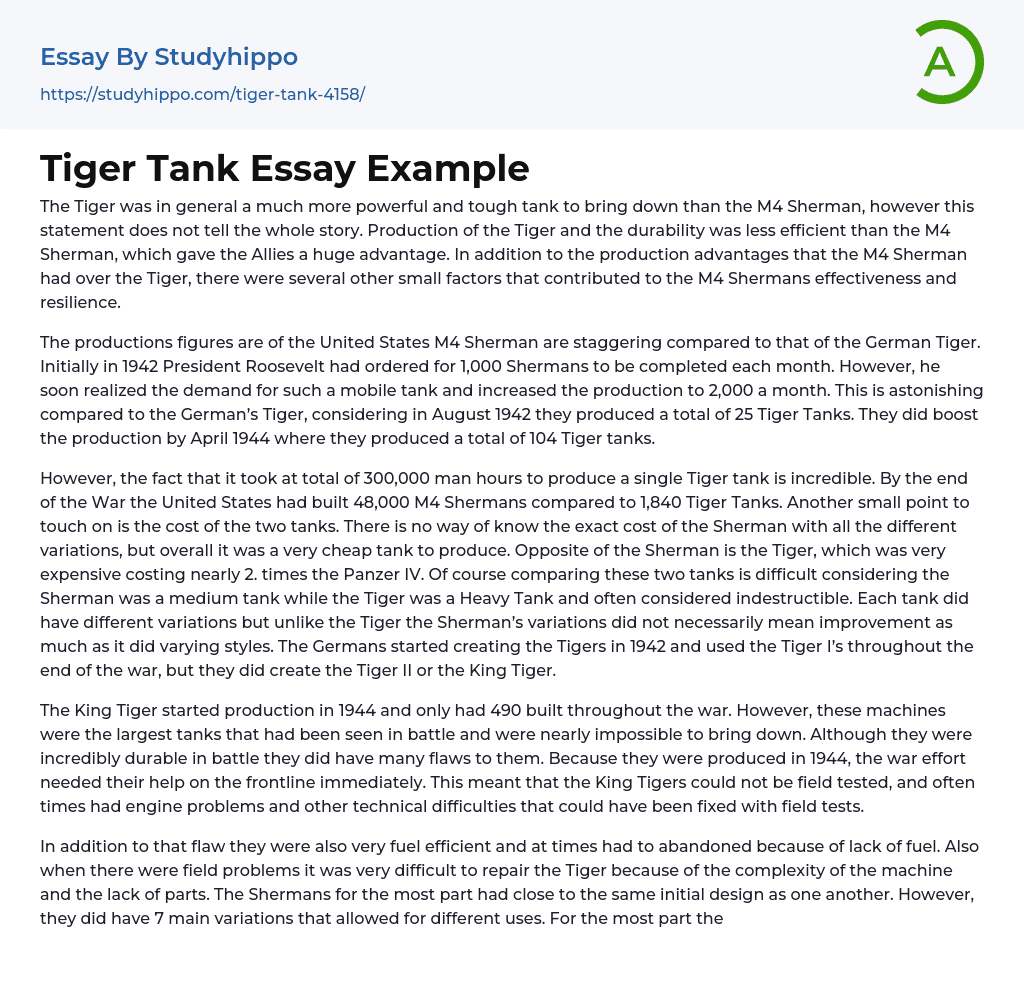The Tiger was in general a much more powerful and tough tank to bring down than the M4 Sherman, however this statement does not tell the whole story. Production of the Tiger and the durability was less efficient than the M4 Sherman, which gave the Allies a huge advantage. In addition to the production advantages that the M4 Sherman had over the Tiger, there were several other small factors that contributed to the M4 Shermans effectiveness and resilience.
The productions figures are of the United States M4 Sherman are staggering compared to that of the German Tiger. Initially in 1942 President Roosevelt had ordered for 1,000 Shermans to be completed each month. However, he soon realized the demand for such a mobile tank and increased the production to 2,000 a month. This is as
...tonishing compared to the German’s Tiger, considering in August 1942 they produced a total of 25 Tiger Tanks. They did boost the production by April 1944 where they produced a total of 104 Tiger tanks.
However, the fact that it took at total of 300,000 man hours to produce a single Tiger tank is incredible. By the end of the War the United States had built 48,000 M4 Shermans compared to 1,840 Tiger Tanks. Another small point to touch on is the cost of the two tanks. There is no way of know the exact cost of the Sherman with all the different variations, but overall it was a very cheap tank to produce. Opposite of the Sherman is the Tiger, which was very expensive costing nearly 2. times the Panzer IV. Of course comparing these two tanks is difficult considering the Sherman was
a medium tank while the Tiger was a Heavy Tank and often considered indestructible. Each tank did have different variations but unlike the Tiger the Sherman’s variations did not necessarily mean improvement as much as it did varying styles. The Germans started creating the Tigers in 1942 and used the Tiger I’s throughout the end of the war, but they did create the Tiger II or the King Tiger.
The King Tiger started production in 1944 and only had 490 built throughout the war. However, these machines were the largest tanks that had been seen in battle and were nearly impossible to bring down. Although they were incredibly durable in battle they did have many flaws to them. Because they were produced in 1944, the war effort needed their help on the frontline immediately. This meant that the King Tigers could not be field tested, and often times had engine problems and other technical difficulties that could have been fixed with field tests.
In addition to that flaw they were also very fuel efficient and at times had to abandoned because of lack of fuel. Also when there were field problems it was very difficult to repair the Tiger because of the complexity of the machine and the lack of parts. The Shermans for the most part had close to the same initial design as one another. However, they did have 7 main variations that allowed for different uses. For the most part the variations were in the engine size or different hull size, but they also were equipped with different extras that were to be used.
A few of these include: rocket launchers, plows, flamethrowers, and minesweepers.
In regard to field repairs the Sherman was very durable. Because of the vast number built, it meant first a simpler design but second many more parts were available. This meant that when a Sherman needed repairs it took less time, money, and expertise to repair the machine Overall the Sherman stayed relatively the same throughout the war excluding a few minor modifications, while the Tiger I and the Tiger II were very different from one another.
- Air Force essays
- Army essays
- Soldiers essays
- Army Values essays
- United States Army essays
- Veteran essays
- Aircraft essays
- Sergeant essays
- World War I essays
- World War Ii essays
- Atomic Bomb essays
- American Civil War essays
- Attack essays
- Cold War essays
- Crimean War essays
- Emilio Aguinaldo essays
- Iraq War essays
- Korean War essays
- Nazism essays
- Nuclear Weapon essays
- Philippine Revolution essays
- Trench Warfare essays
- Vietnam War essays
- Western Front essays
- Diplomacy essays
- Emperor essays
- Rwanda essays
- Tribe essays
- Revolutionary War essays
- War of 1812 essays
- Mexican American War essays
- Hitler essays
- The Spanish American War essays
- League Of Nations essays
- Battle Of The Somme essays
- Treaty Of Versailles essays
- Fascism essays
- D-day essays
- Atomic Physics essays
- Atomic Bombings Of Hiroshima And Nagasaki essays
- Electron essays
- Absolutism essays
- Appeal essays
- Bourgeoisie essays
- Contras essays
- Corporate Governance essays
- Corruption essays
- Democracy essays
- Democratic Party essays
- Developed Country essays




